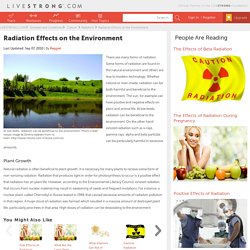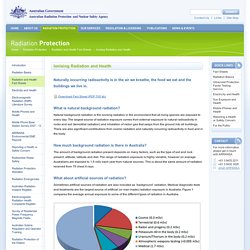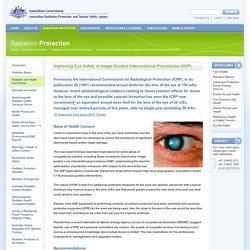

Natural radiation report. Home: Radiation - Department of Health and Human Services, Victoria, Australia. This site provides information about the Department of Health & Human Services role in protecting workers, the public and the environment from the harmful effects of radiation.

Radiation Protection Series Fundamentals (RPS F-1) What is Radiation? Types of Radiation. Radiation and Its Health Effects. More than 100 years ago, scientists discovered that many elements commonly found on Earth occur in different configurations at the most basic (atom) level.

These various configurations (called isotopes) have identical chemical properties, but different physical properties. In particular, some isotopes (known as radioisotopes) are radioactive, meaning that they emit energy in several different forms. This energy emission is what we call radiation. Over time, we have come to think of radiation in terms of its biological effect on living cells. Radiation Effects on the Environment. There are many forms of radiation.

Some forms of radiation are found in the natural environment and others are due to modern technology. Whether natural or man-made, radiation can be both harmful and beneficial to the environment. The sun, for example can have positive and negative effects on plant and animal life. At low levels, radiation can be beneficial to the environment. On the other hand ionized radiation such as x-rays, gamma rays, alpha and beta particles can be particularly harmful in excessive amounts. Natural radiation is often beneficial to plant growth. Ionizing radiation, health effects and protective measures.
ARPANSA - Ionising Radiation and Health. Ionising Radiation and Health Naturally occurring radioactivity is in the air we breathe, the food we eat and the buildings we live in.

The Radiation Boom - After Stroke Scans, Patients Face Serious Health Risks. MRI scans 'lead to unnecessary breast surgery' Cernobyls Children Show DNA Changes. Chernobyls Effects Linger On. ARPANSA - Radiation and Health Fact Sheets. Skip to content.

Foundation for Fundamental Research on Matter. Rps1.pdf. Radiation exposure. UV radiation from the sun. Skin cancer - Cancer Council Australia. Skin cancer occurs when skin cells are damaged, for example, by overexposure to ultraviolet (UV) radiation from the sun.

Every year, in Australia: skin cancers account for around 80% of all newly diagnosed cancersbetween 95 and 99% of skin cancers are caused by exposure to the sunGPs have over 1 million patient consultations per year for skin cancerthe incidence of skin cancer is one of the highest in the world, two to three times the rates in Canada, the US and the UK. Radiation and Health Fact Sheets. Skip to content ARPANSA - Australian Radiation Protection and Nuclear Safety Agency Radiation Protection quick links contact For more information please get in touch with ARPANSA.

Aprons for Protection against X-rays. Aprons for Protection Against X-rays It is recommended that all aprons should comply with Australian Standard AS/NZS 4543.3:2000 for light and heavy aprons depending on the application.

Cell Phones and Cancer Risk. Epilation-laser-hair_removal-eng.pdf. Scans for Children: Information for Referrers. CT Scans for Children: Information for Referrers In Australia there are now over 80 0001 computed tomography (CT) scans performed on children and young people under the age of 20 every year.

CT is a valuable investigative technique because it provides a low risk, non-invasive, fast and accurate method of diagnosing serious injury and illness. However, all these benefits come with an increased exposure to ionising radiation which has been linked to an increased risk of cancer. Fact Sheet:Improving Eye Safety in Image Guided Interventional Procedures (IGIP) Improving Eye Safety in Image Guided Interventional Procedures (IGIP) Previously the International Commission on Radiological Protection (ICRP), in its publication 60 (1991) recommended annual limits for the lens of the eye at 150 mSv.

However recent epidemiological evidence relating to tissue reaction effects for doses to the lens of the eye and possible cataract formation has seen the ICRP now recommend¹ an equivalent annual dose limit for the lens of the eye of 20 mSv, averaged over defined periods of five years, with no single year exceeding 50 mSv. Lasers and Intense Pulsed Light (IPL) Sources. Lasers and Intense Pulsed Light (IPL) Sources Used for Cosmetic Purposes Lasers and Intense Pulsed Light sources (IPLs) devices used for cosmetic purposes can cause serious health effects such as burns, scarring and eye damage. Introduction Lasers and Intense Pulsed Light sources (IPLs) are devices used for a range of cosmetic purposes including: removing hair, tattoos, birthmarks and various skin lesions, cellulite, acne and acne scarring reducing the visibility of blood vessels and skin pigmentations rejuvenating the skin reducing the appearance of fat.
What Parents Should Know about CT Scans for Children. What Parents Should Know about CT Scans for Children A computed tomography (CT) scan is an X-ray imaging technique that is used on people of all ages, including children. CT scans are vitally important for quickly investigating serious health problems inside the body, for example, bleeding inside the skull after a fracture. Solariums (sunbeds and tanning beds) A solarium is any tanning unit that uses UV radiation to tan the skin. Solariums are also known as sunbeds, sunlamps or tanning beds. There is no such thing as a safe solarium tan. South-australia-nuclear-toilet.jpg (JPEG Image, 540 × 549 pixels) Five Things You Need to Know About the Radioactive Plume Approaching the West Coast. The radioactive plume of contaminated water said to be heading across the Pacific Ocean after Japan’s 2011 Fukushima nuclear disaster will reach the United States within a month, scientists now think. Tuesday marks the third anniversary of the earthquake, tsunami and nuclear disaster, known in Japan as 3.11.
The disaster killed nearly 16,000 people and left more than 2,000 unaccounted for in vast areas of its northern coast. Since then, the country has struggled to rebuild tsunami-hit communities and to clean up radiation from the nuclear crisis. About 50,000 people from Fukushima are still unable to return home due to concerns over radiation. Officials comb the area for any signs of missing people three years after the disaster in Namie, near the striken TEPCO Fukushima Dai-ichi nuclear plant in Fukushima prefecture on March 10, 2014, one day before the third anniversary of the March 11, 2011 massive earthquake and tsunami. 891219-nuclear-art.jpg (JPEG Image, 650 × 447 pixels) Fukushima_radiation_nuclear_fallout_map.jpg (JPEG Image, 594 × 329 pixels)
Hiroshima_and_nagasaki_victims_nuclear_bombing.jpg (JPEG Image, 550 × 414 pixels) Radiopaedia.org, the wiki-based collaborative Radiology resource. X-Ray Laser Able to Snap Photos of Electrons. Superman may make it seem easy, but it's actually difficult to create narrow, directed beams of X-rays. While visible-light lasers have been common for a decade as presentation pointers and cat toys, the first X-ray laser wasn't created until two years ago. Now a team of scientists is announcing today (June 7) that they've created a newer, smaller X-ray laser.
It is the first model that fits on a table and doesn't require a miles-long particle accelerator to produce the X-ray beam. The new tool could help scientists watch tiny phenomena, such as the movements of electrons. Such studies would speed the development of new materials for computing efficiency, green energy and other uses. Objectives of the Society for Radiological Protection - The Society for Radiological Protection - SRP.
The SRP was founded as a learned society in 1963. Solarium victim Clare dies at 26 - National - smh.com.au. Cancer patient Clare Oliver who led a campaign to regulate the solarium industry, died this morning in hospital, doctors said. Radiation from Fukushima to reach West Coast in April. On the third anniversary of the Fukushima nuclear plant incident, scientists are reporting that low levels of radiation from the Fukushima plant will reach ocean waters along the U.S. West Coast by April 2014. The scientists say that the radiation will be at levels too low to harm humans, but they call for more monitoring, including at the federal level. X Ray. Radiation.
Timeline-human-radioactive.gif (GIF Image, 360 × 224 pixels) Tumblr_nl9bs7lctn1slixf5o1_500.jpg (JPEG Image, 500 × 500 pixels) Electromagnetic radiation - Science (9) RadonMap.pdf. Ionising and Non Ionising Radiation. Radiation Basics - Ionising and Non Ionising Radiation Ionising radiation has more energy than non ionising radiation; enough to cause chemical changes by breaking chemical bonds. What is the electromagnetic spectrum? The electromagnetic spectrum includes radio waves, microwaves, infrared rays, light rays, ultra violet rays, X‑rays and gamma rays.
RadTown USA.